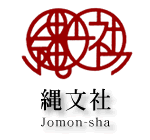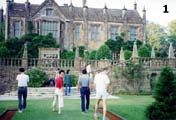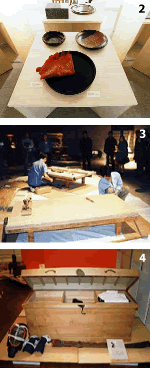
 |
We would like to show some
information on the activities of Jomon-sha.
Non-profit activities Jomon-sha's main goal
is to provide and organize various non-profit activities with
the grants from foundations. The activities include planning and
designing symposiums at various local craft artist communities,
and study tours to visit the United States, Italy and other exciting
countries. Starting from 1994, for over a period of seven years,
special events have been organized to provide opportunities to
promote active interchange in craft art business with England.
In the initial three years, special seminars were held at Parnham
College in Dorest. The program gave the participants an opportunity
to better understand craft works in the different countries, the
skills involved in the art, as well as the retail distribution
supporting the arts. The program aimed to enhance and educate
as well as to provide valuable networking opportunities. In the
following three years, a joint program with Tohoku University
of Art and Design, Toyama National Junior College, Hokkaido Tokai
University, invited a team of professors from Parnham College,
for a very fruitful workshop. In the year 2000, a group visited
Dorest, England for a study tour. The silk weaving artist from
Okinawa, the initiator of the economic development projects of
Nakatomi City in Yamanashi Prefecture, through washi paper making,
and the urban designer of Wajima City, represented the group.
The program provided rich learning experiences for the group on
the close network and partnership that exists among the craft
artists and their local community.
|
|||||||||||
|
|
Exhibitions
At Living Design Center OZONE in Shinjuku, Tokyo, Jomon-sha oraganizes special exhibitions and events designed to foster deeper understanding of the traditional crafts culture, that continues the ways of their ancestors, using natural material, and refined skills. Jomon-sha explores the potentials of new creative developments through each exhibition. We also dedicate to organize exhibitions to enhance the interests in the traditional crafts especially among the younger generation. Below are some of the events we have organized in the past: Free Style Urushi Lacquerware presented variety of ways to use urushi lacquer as a natural material to cover various surfaces such as wood, stones, copper, stainless steel, paper, leather, bamboo, silk yarn, etc.. Sample products were displayed and demonstrated new ways of using urushi lacquer. (Photo 2: urshi lacquer applied on a tray covered by leather )(1994). At the exhibition of Handmade Paper for Interior Decoration, various types of handmade paper were collected from every corner of Japan. Some interesting items were paper coated with persimmon sap and urushi lacquer, (which is also the sap from urushi tree), Kyo fusuma sliding screen paper, which is paper embossed with wood block designs, (from wood blocks kept for more than three hundred years at the old papermaking house in Kyoto), Edo fusuma sliding screen paper and hand crumpled paper. The purpose of the exhibition was to promote the unconventional way to use handmade paper which is slowly drifting away from our everyday lives. In addition, the exhibition demonstrated the painstaking and labour-intensive craft of paper making, which too has consequently led to the decline in production by the years with the fewer interests in successors. The exhibition also displayed unique paper works made by paper artists, collected from all over Japan.(1996) (photo 3) The aim of The Joy of Bamboo Weaving exhibition was to show the wide variety of bamboo weaving patterns as well as bamboo baskets made with unique techniques. At the workshops, the pubic participants had the opportunity to actually enjoy making small flower baskets guided by bamboo craftsmen.(1995) Edo Joinery Exhibition displayed exquisite joinery works, which has been passed down through the system of apprenticeship since the Edo period. At the workshop visitors enjoyed the rare opportunity to see how these fine joinery works were created. Samples of various types of joineries were shown and special tools such as planes, chisels and saws were also exhibited.(1997) The Traditional
Crafts for Our Beloved Children attracted an audience of all
ages. This exhibition was planned with hopes to show the public,
especially in this “throw-away age”, how important it
is for the children to have objects they cherish and use during
their childhood, and continue to treasure throughout their lifetime.
Craftsmen who were fathers of young children shared their concerns
and volunteered to make lifetime wood furniture and crafts for
the exhibition.(1997) (photo 4) |
|||||||||||
|
Publications and making of web sites In 1997 Jomon-sha was assigned to create the English pages for the Traditional Crafts of Japan web site (http//www.wnn.or.jp/wnn-craft/), sponsored by the governmental foundation, Japan Traditional Craft Center. On the web site, one finds over 200 items designated as official traditional crafts by the government, with explanation and a list of craftsmen engaged in the making of these crafts. This edition in English was the first of its kind on the internet. Jomon-sha was also assigned to prepare the English edition of the voluminous book Japan Traditional Craft Industries. This ambitious project when completed resulted in an eight volume series filled with lustrous photographs. Japanese corporations have donated these volumes to major libraries and institutions in the US, with hopes to promote to a wider international audience. Jomon-sha undertook another great task in compiling and editing the Japan Crafts Sourcebook published by Kodansha International Inc. In this book, 91 craft items are represented with informative text and large colorful photographs. The book provides information on the materials used, the arduous skills and techniques involved, and a brief history on the regions of origins of these crafts. You may find it interesting to know how the 91 different crafts featured have developed and skills refined over many generation through the history and how they still remain an integral part of culture today in this country. Japan Crafts Sourcebook can be found in most English-speaking countries since its publication in 1996. You may also find it at the Metropolitan Museum bookstore in New York.
Compared to few decades ago, today with changing values in our lifestyle, Japanese people using traditional crafts in their daily lives continues to diminish in number. With modern technology, mass produced objects that are low priced, handy and contemporary in style are replacing these crafts. Over a period of ten years, Jomon-sha has been engaged in many activies and we feel it is imperative to find more markets and new ideas to keep the trditional hamdmade craft activities alive and become more a part of our modern daily lives. The web site not only provides information on the crafts, but also offers the viewers the opportunity to hear and learn more directly from the craftsmen through their personal essays about their commitment and dedication. Craftsmen are often assumed to be silent, but we found that they are filled with desires to express themselves and anxious to communicate with the users. handmadejapan.com will be one of the few places where craftsmen can express themselves and where readers can learn more about their passion for hand making objects. At the same time, the site serves as an excellent platform for the craftsmen to receive feed backs from the viewers and people who share the pleasure of using traditional craft works. handmadjapan.com hopes this new approach will serve to encourage traditional crafts artisans to carry on their activities, and become a bridge between the creators and users, and create an enduring dialogue among diverse people with different interests. The theme of handmadejapan.com is ‘Old but New’. We will introduce craftsmen whose works are based on the centuries-old tradition, and have added personal expression bringing something new and original to the definition of traditional crafts. We hope that the site will entertain you, as well as lead you to become attached to handmade crafts and find the pleasure of owning and using them. Our goal is to make the Japanese handmade objects available on the internet for more people to enjoy. But we are happy to receive letters from you if you have special interests in Japanese handmade arts and crafts. Many people are involved in the making handmadejapan.com and we gratefully acknowledge their contribution. We owe a debt of gratitude to Diane Durston, (author of Old Kyoto, a Guide to Traditional Shops, Restaurants, and Inns,published by Kodansha International, 1986) and to Nana Ozawa for the continued guidance and preparation of the English text. We also appreciate the help from our visitors who continue to alert us to possible improvements, thereby assuring that this site remains meaningful and attractive.
|
||||||||||||

